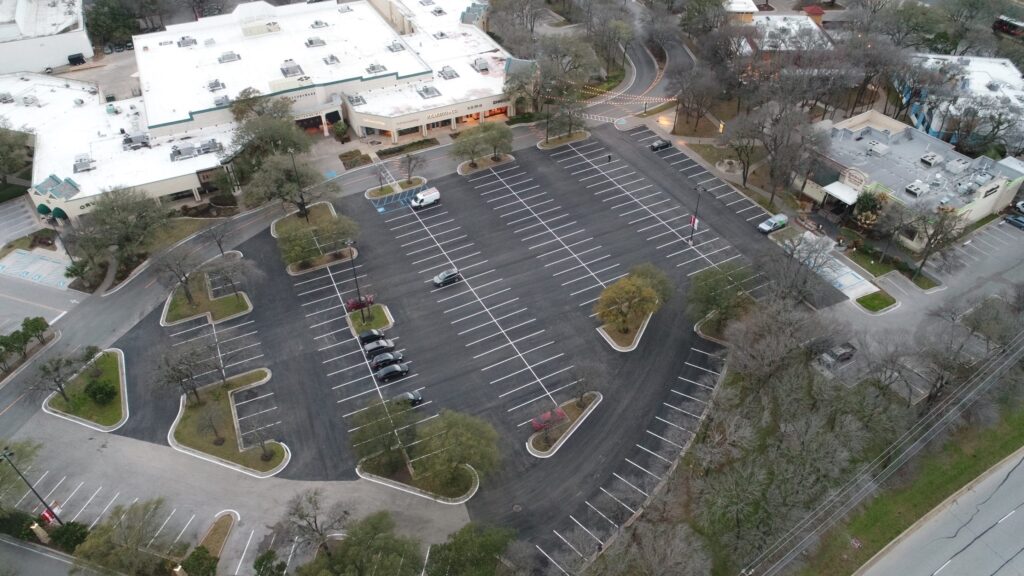 The success of a sealcoating job and the time that the newly sealed area must remain closed are highly dependent on the weather. Temperature, sunlight, humidity and wind speed are all factors that must be considered by your Austin, TX seal coat professional. Of the four critical factors, wind speed is the one that is often misunderstood.
The success of a sealcoating job and the time that the newly sealed area must remain closed are highly dependent on the weather. Temperature, sunlight, humidity and wind speed are all factors that must be considered by your Austin, TX seal coat professional. Of the four critical factors, wind speed is the one that is often misunderstood.
Asphalt Sealing & Windy Conditions
The Challenge of Sealcoating Without Wind
Sealcoating professionals prefer to apply sealants when there is a gentle breeze of at least 3 mph. Sealants contain water that must evaporate for drying and curing to occur. As the water evaporates, it collects immediately over the sealed pavement, blocking the additional evaporation of the water that is still trapped in the sealant. A gentle breeze is enough to move the saturated air away so that evaporation can continue.
The Challenges of Sealcoating on Windy Days
Although a little wind is beneficial, too much wind can pose a number of problems. Reputable, experienced contractors have a threshold for wind speed and will not attempt to apply sealant if the wind speed exceeds that point. Here are some of the potential pitfalls of sealcoating on very windy days.
• The higher the wind speed, the faster the sealant will dry. This may seem beneficial, but it can actually ruin the sealcoating job. The problem is that the sealant will dry from the top down. As the underlying sealant dries, cracks can then develop that make the surface less attractive and reduce the life of the sealcoating.
• High winds can blow grass clippings, dust, trash and other debris onto the wet sealant. Such debris could potentially remain permanently affixed to the sealant or damage the finish when the debris is forcibly removed.
• While the sealant is being sprayed onto the pavement, a strong wind could blow the sealant onto nearby passing or parked cars, walls, grass, fences, curbs, buildings, sidewalks, signs, HVAC equipment, shrubs or other items. The ease with which the sealant can be removed depends on the item’s finish. For example, sealcoating can be extremely difficult to remove from vinyl siding, and even if the sealant is successfully removed, stains may be left behind.
• High winds can disrupt the spray pattern. This can prevent a uniform application and leave some areas of the pavement without proper protection.
• Some contractors attempt to counteract high winds by manually applying sealant in a wide swath around the perimeter of the pavement. This slows the job, but it can also result in the application of too much or too little sealant. Other contractors use blocker boards to spray the edges, but unless they are skilled and very careful, sealcoating can drip from the blocker boards every time they are moved.
Your best protection against a shoddy sealcoating job and/or sealant where it does not belong is to hire a credible contractor. If a contractor tells you that he can apply sealcoating in any weather, walk away — because even if he offers to seal your pavement for free, it will not be worth the price.
If you want seal coating done right, contact the experts at Alpha Paving. We apply more gallons of asphalt sealcoating annually than any other contractor in Texas. We also offer asphalt paving, road construction, milling, asphalt repairs, asphalt overlays, street maintenance, parking lot striping, concrete work and many other pavement-related services. We deliver exceptional work to a variety of Austin and Central Texas clients, including shopping malls, municipalities, hotels, counties, schools, grocery stores, restaurants, apartment complexes, airports, subdivisions, hospitals, office complexes, national retail chains and HOAs. If you have more question about Asphalt Sealing & Windy Conditions or would like a free quote, submit the online form or call (512) 677-9001.




